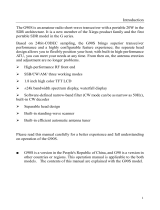iv
4 Paddle Polarity ……………………………… 50
5 Keyer Type ………………………………… 50
6 MIC U/D Keyer (HM-103) ………………… 50
D Paddle operation
from [MIC] connector ………………………… 50
■ Operating RTTY (FSK) ………………………… 51
D Convenient functions for receive …………… 52
D RTTY reverse mode ………………………… 53
D Twin peak filter ………………………………… 53
D Functions for the RTTY decoder indication… 54
D Setting the decoder threshold level ………… 54
D RTTY decode set mode ……………………… 55
1 RTTY Decode USOS ……………………… 55
2 RTTY Decode New Line Code …………… 55
D Pre-setting for using RTTY terminal or TNC 56
■ Operating AM …………………………………… 57
D Convenient functions for receive …………… 57
D Convenient functions for transmit …………… 58
■ Operating FM …………………………………… 59
D Convenient functions for receive …………… 59
D Convenient functions for transmit …………… 59
D Tone squelch operation ……………………… 60
D Tone scan operation ………………………… 61
D DTCS operation ……………………………… 62
■ Repeater operation ……………………………… 63
D One-touch repeater function ………………… 63
D Repeater tone frequency …………………… 64
D Transmit frequency monitor check ………… 65
D Auto repeater function ……………………… 65
D Storing a non standard repeater …………… 66
■ 1750 Hz tone burst ……………………………… 67
■ DTMF memory encoder ………………………… 67
D DTMF send menu …………………………… 67
D Programming a DTMF code ………………… 68
D DTMF speed…………………………………… 68
■ TV channel operation …………………………… 69
D Convenient functions for receive …………… 69
D Skip channel setting ………………………… 70
D Channel frequency adjustment ……………… 71
5 FUNCTIONS FOR RECEIVE…………… 72–84
■ Simple band scope ……………………………… 72
D Fix mode ……………………………………… 72
D Center mode…………………………………… 73
D Scope set mode ……………………………… 73
1 Max Hold …………………………………… 74
2 Scope Size ………………………………… 74
3 FAST Sweep………………………………… 74
4 FAST Sweep Sound ……………………… 74
■ Preamp and attenuator ………………………… 74
■ RIT function ……………………………………… 75
■ AGC function …………………………………… 76
D AGC time constant selection ………………… 76
D Setting the AGC time constant ……………… 76
■ IF filter selection ………………………………… 77
D IF filter selection ……………………………… 77
D Filter passband width setting
(SSB/CW/RTTY/AM only) …………………… 78
D IF filter shape (SSB/CW only) ……………… 78
■ Twin PBT operation …………………………… 79
■ Noise blanker …………………………………… 80
D Noise blanker set mode ……………………… 80
1 NB Level …………………………………… 80
2 NB Width …………………………………… 80
■ Noise reduction ………………………………… 81
D Noise reduction set mode …………………… 81
➥ NR Level …………………………………… 81
■ Notch function …………………………………… 82
D Auto notch function …………………………… 82
D Manual notch function………………………… 83
D Manual notch filter set mode ………………… 83
■ Voice squelch control function ………………… 84
■ Meter peak hold function ……………………… 84
6
FUNCTIONS FOR TRANSMIT
………… 85–94
■ VOX function …………………………………… 85
D Adjusting the VOX function ………………… 85
D VOX set mode ………………………………… 86
1 VOX Gain …………………………………… 86
2 Anti-VOX …………………………………… 86
3 VOX Delay ………………………………… 86
■ Transmit filter width setting (SSB only) ……… 86
■ Break-in function ………………………………… 87
D Semi break-in operation ……………………… 87
D Full break-in operation ……………………… 87
■ ∂TX function …………………………………… 88
■ Monitor function ………………………………… 89
■ Speech compressor …………………………… 89
D Compression level setting …………………… 90
➥ COMP Level ……………………………… 90
■ Split frequency operation ……………………… 91
■ Quick split function ……………………………… 92
D Split offset frequency setting ………………… 93
D Quick split setting …………………………… 93
■ Measuring SWR …………………………………… 94
D Spot measurement …………………………… 94
D Plot measurement …………………………… 94
7 VOICE RECORDER FUNCTIONS …… 95–101
■ Digital voice recorder …………………………… 95
■ Recording a received audio ……………………… 95
D Basic recording ……………………………… 95
D One-touch voice recording…………………… 96
■ Playing the recorded contents …………………… 96
■ Erasing the recorded contents…………………… 97
■ Recording a message for transmit ……………… 98
D Recording ……………………………………… 98
D Confirming/Erasing the recorded message… 98
■ Programming a memory name for transmit …… 99
■ Sending a recorded message ………………… 100
D Transmit level setting ……………………… 100
■ Voice set mode…………………………………… 101
D Voice set mode ……………………………… 101
1 Auto Monitor ……………………………… 101
2 MIC Memo ………………………………… 101
TABLE OF CONTENTS
1
2
3
4
5
6
7
8
9
10
11
12
13
14
15
16
17
18
19
20





















